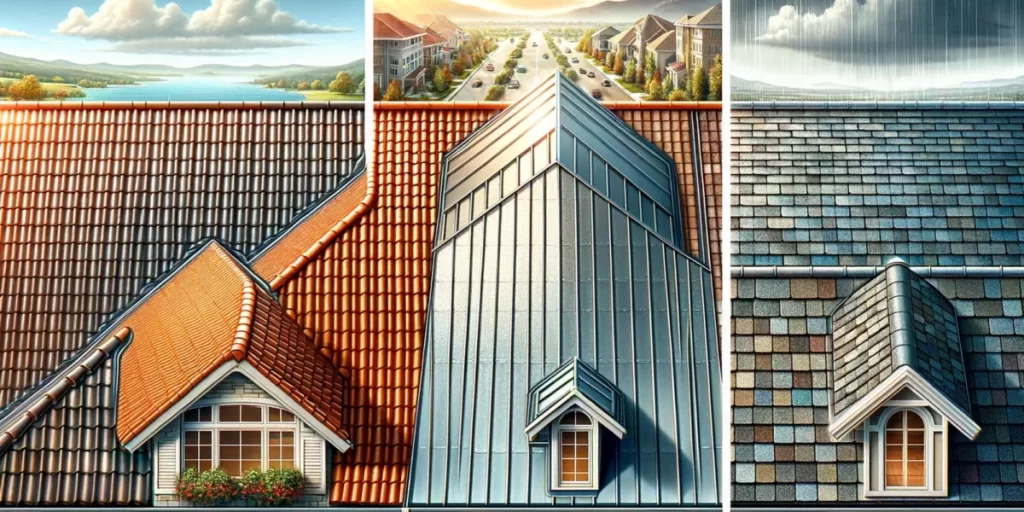It is important to know all of your options when selecting roofing materials. Each type has its own benefits which can help achieve the desired appearance and atmosphere in your home or building.
Wood shingles and shakes are very durable roofing materials that can last a long time, especially if they are installed in areas with high fire risks. When choosing class A wood shingles or shakes with fire retardant coating, make sure they have been treated accordingly.
Asphalt
If you want reliable protection at an affordable price then go for asphalt roof shingles as they are considered to be the best in these aspects.
Asphalt shingles are lightweight and come in various colors so homeowners can choose what suits their taste best or matches other exterior elements of the house. This wider range of design options increases their curb appeal too. Compared to long sheets of metal or thick pieces of slate, asphalt shingles tend to be easier handled during installation hence reducing labor costs; also less expensive when replaced after getting damaged.
There is a wide range of architectural styles available under asphalt roofing such as traditional three-tab shingles, cedar shakes (more expensive) or even slate materials. These shingles boast good resistance against fires; they can be cleaned easily and may feature granules that resist algae growth thus reducing blue-green algae on roofs. They offer better resistance against fires as well as lower maintenance but have shorter life span compared to other types used for covering roofs like tiles.
Metal
When it comes to durability, no other material beats metal roofs which often come with warranty periods ranging between 30-50 years – this is more than double what asphalt offers! Besides being longer lasting than any other commonly used roofing materials, metals provide additional protection against fires in regions prone to wildfires like Texas because non-combustible nature makes them highly fireproof too.
Stainless steel, aluminum and galvanized steel are some examples of long-term roofing materials that can last between 60-100 years. Copper adds a beautiful patina to any home while being highly resistant to corrosion.
Metal roofs are also energy efficient compared to asphalt shingles since they reflect sunlight instead of absorbing it therefore leading into considerable savings on energy bills. In addition, unlike asphalt shingle roofs, metals can be easily insulated to prevent heat loss during winter and keep homes cool during summer – besides metals being eco-friendly as they can be recycled once their useful life has come to an end – many homeowners have reported increased curb appeal and value after installing one!
Wood
Wood may no longer be the first choice for many people due to availability of more resilient options against weathering but still there are instances where it would make a great selection. Wood shakes or shingles impart an old-fashioned charm which is loved by some; moreover, they possess natural insulation properties that help lower heating costs while creating warm atmosphere throughout the year.
The durability and maintenance needs of your roof largely depend on the wood species you choose. Machine-sawn shingles tend to have less character than hand split shakes – latter look rougher due variations in grain pattern. Both will give unique aesthetic appeal and set apart your house from others!
Wallaba provides an eco-friendly sustainable option; these shingles only undergo treatment with resins and exudates not chemical preservatives hence suitable for tropical equatorial climates, additionally insects mold corrosion resistance is better exhibited in natural wooden coverings against them.
Clay Tiles
If you’re a homeowner who wants a roof that requires very little upkeep, clay tiles are an ideal choice. The reason behind this is their ability to resist moisture absorption so as not to allow the seepage of water into the building which might cause damage.
Moreover, clay tile roofs are quite flexible since they can be molded into various shapes and textures to fit any style of architecture. In the US Southwest, for example, mission-style barrel tiles may be used while interlocking shingle designs can also be adopted depending on what suits your residential or commercial structure best.
Clay is sustainable at every stage: from being dug up out of the ground through its manufacturing process — even if there’re some left over after installation they can still serve as raw materials for other tiles or bricks elsewhere. Additionally clay has an extremely long lifespan when used as roofing material thus reducing energy consumption over time due to frequent replacement unlike most alternatives. Fire resistance being another advantage that does away with need for preservatives making it top notch among eco-friendly building materials according to environmentally conscious owners of real estate.







More Stories
Top Types of Roofing Materials
Types of Home Roofing
What to Expect From a Roof Repair Contractor